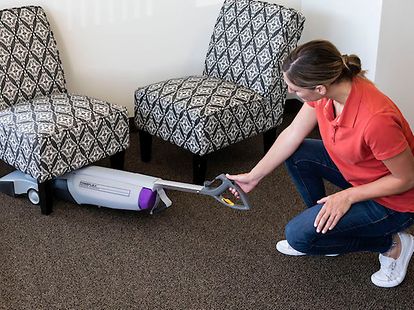Today, with the help of our partners at ProTeam, we're answering your biggest questions about how to select the perfect vacuum for your company's needs.
How do I choose between an upright, backpack, or canister vacuum?
Start by thinking about the cleaning applications your vacuum is being used for. For mid-size to large jobs, a backpack vacuum will allow users to move through a space quickly and efficiently. The attachments make for a versatile tool that can clean not only carpets, but ceiling fan blades, curtain rods, and more. Backpack vacuums are particularly efficient on stairs because they do not need to be repositioned with every step.
For small jobs or tight quarters, an upright or canister vacuum may be a better choice because they are quick and simple to set up. Upright vacuums are easy to store and excellent at deep-cleaning carpets, though they can be heavier and louder than the other vacuum types. Canister vacuums excel on bare floor, drapes, and upholstery. Their small profile and additional flexibility of a canister vacuum also make this vacuum type a great choice for cleaning under furniture.
Do I need more than one kind of vacuum?
Some cleaning programs include a range of vacuum types to meet different needs. Others prefer consistency, which simplifies training and equipment maintenance. In buildings with mostly low-pile commercial carpet and hard flooring, a backpack vacuum should meet all your needs. However, if you are constantly switching environments, flooring types, and soil levels, it might be beneficial to have more variety in the types of vacuums that you use.
Why should I consider a cordless/battery-powered vacuum?
Corded vacuums are efficient, powerful, and relatively inexpensive compared to cordless vacuums. With no battery, they can be operated for as long as needed. However, their range is limited by the cord so they will need to be frequently unplugged, moved, and plugged in to reach different areas. The cord can also be a trip hazard so timing and traffic flow during cleaning should be considered.
By comparison, cordless vacuums are powerful, compact, agile, and easy to set up. Their most important benefit is that they can go anywhere, improving cleaning speed and safety in crowded environments like classrooms and cubicles. They are also ideal for navigating stairwells, elevators, and building occupants in 24-hour facilities. However, a cordless backpack is generally more expensive than a corded vacuum and has a finite battery capacity, so charge time should be considered when choosing your cleaning goals.
Read More: Cordless backpack vacuum cleaners are a game changer in safety, speed and cost reduction
What is considered a quiet vacuum?
66 decibels or less will not to disturb normal conversation happening nearby. Some models can operate at this level with full commercial suction power while other vacuums have a "quiet mode," which lowers the suction power. You should consider both sound and suction needs when choosing your vacuum.
The Clean Up
When choosing your next vacuum, consider the needs of your job: How big is the space? How maneuverable do you need the vacuum to be? How far do you need it to move and for how long? From there, you can decide which vacuum has the perfect features to meet those needs. Ask your Maintex representative for further guidance on choosing the perfect vacuum.



